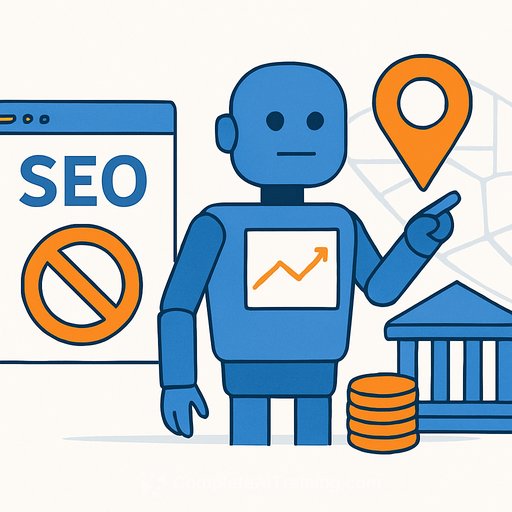AI brands are moving offline: pop-ups and events are building awareness and trust
People want to see how AI works, not just hear about it. That's why brands are leaning into pop-ups, demos, and museum-style encounters that invite questions and hands-on trials.
Interactive exhibits, like the "Adventures in AI" installation at the Exploratorium, show there's demand for spaces where people can test, learn, and challenge assumptions. Bring that energy to your next campaign and you'll convert curiosity into qualified demand.
Why in-person beats another banner ad
- Trust gap: face-to-face demos reduce uncertainty, especially for products that use data.
- Tactile proof: seeing outputs, latency, and guardrails converts skeptics faster than a landing page.
- Context control: you set the environment for questions on bias, privacy, and safety-without hot takes derailing the story.
- Earned reach: attendees create UGC, giving you authentic social proof and content reuse.
Strategy blueprint for your AI pop-up
- Objective: pick one primary goal-awareness, free trials, or qualified leads.
- Audience: define the use case storyline by segment (marketers, ops, sales, creators).
- Location: near category events, coworking hubs, campuses, or high-footfall retail corridors.
- Format: 10-minute guided demo, self-serve stations, or small-group workshops every hour.
- Message: "Safe, useful, here's how it helps today." Keep it simple and outcome-first.
- Experience arc: attract → orient → demo → Q&A → opt-in offer → follow-up.
Experience ideas that actually work
- Try Stations: hands-on tasks tied to real workflows (ad copy, reporting, outreach).
- Prompt Challenge Wall: attendees post prompts and compare outputs live.
- Transparency Bar: show what inputs are used, what's stored, and how to control it.
- Bias & Quality Corner: test edge cases and show how human review fits in.
- Privacy Desk: on-the-spot consent, data deletion, and "no training" preferences.
- Kids' Table: simple, playful tasks-if a child can grasp it, the story is clear for everyone.
Hard questions to invite (and answer)
- What data do you collect, keep, and for how long?
- Can our content be excluded from training? Show the setting and policy.
- Where does human review happen in high-risk cases?
- How do you address bias and misuse?
- What failsafe exists if the model gets it wrong?
- What ROI should a mid-market team expect in 30-60 days?
Operational checklist
- Short, plain-language consent forms with QR opt-in and instant email receipt.
- Visible signage: what's collected on-site, what's optional, and support contacts.
- Offline-ready demos to prevent Wi-Fi issues; device cleaning between uses.
- Staff scripts for privacy, security, and pricing questions.
- Real-time analytics: footfall, dwell time, demo completion, opt-ins, and notes.
Metrics that prove it worked
- Footfall and dwell time by zone.
- Demo completion rate and time-to-first-value.
- Opt-in rate, cost per qualified lead, and meeting set rate.
- Trust lift: pre/post survey on "comfort using this product with my data."
- UGC volume and share rate; conversion lift in event ZIP codes vs. control.
Post-event nurture flow
- Within 24 hours: thank-you email, recap, and the exact prompts used on-site.
- Within 72 hours: a case study matching their role and a 14-day guided trial.
- Day 7: live office-hours Q&A; day 14: ROI mini-workshop with a worksheet.
- Segment by interest (copy, analytics, outreach) and route to role-based cadences.
Budget and build options
- Scrappy (5-15k): one staffed booth, 2 laptops, QR flows, vinyl signage.
- Mid (30-75k): multi-station pop-up, content capture crew, small workshop space.
- Partnered: co-host with a museum, university, or coworking brand for credibility and reach.
What museums can teach marketers
Exhibits thrive on curiosity, clear explanations, and safe spaces for tough questions. That's the template for AI activations that don't feel like sales pitches.
If you need inspiration, look at science centers that invite people to test ideas, not accept them blindly. The Exploratorium's focus on hands-on learning is a useful model for turning complex topics into simple, shared experiences. Explore the format.
Sample one-week event calendar
- Mon: soft launch in a coworking lobby (role-specific demos every hour).
- Wed: evening workshop for local marketers-bring your brief, leave with assets.
- Fri-Sat: street-level pop-up near a tech conference; content team filming UGC.
- Sun: partner session with a community group; local case studies and discounts.
Team roles
- Producer: venue, permits, schedule.
- Demo lead: scenario design, hardware, offline backups.
- Privacy lead: consent flows, signage, and data handling.
- Creator crew: social capture, edits, and same-day posts.
- Sales ops: lead routing, qualification rules, and follow-up SLAs.
Common mistakes to avoid
- Abstract messaging with no live use case.
- No clear opt-in path or messy data capture.
- Staff who can't answer questions about data handling and bias.
- Leaving without content-film everything, publish same day.
Further resources
- Edelman Trust Barometer for benchmarks on trust and communication cues that matter.
- AI Certification for Marketing Specialists to level up team skills before you go live.
Bottom line: bring AI into the real world, answer hard questions in plain language, and let people test it for themselves. Trust follows proof.
Your membership also unlocks:






